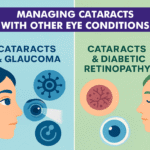In the modern era of cataract surgery and refractive lens exchange, intraocular lenses (IOLs) play a pivotal role in restoring vision. Among the options available, monofocal vs multifocal lenses often emerge as a primary decision point for patients and surgeons alike.
We understand that choosing the right lens after cataract surgery can feel overwhelming. This guide is here to walk you through both options—monofocal and multifocal lenses—so you can make a confident, well-informed decision that aligns with your lifestyle and comfort.
This guide offers a detailed look into both types of lenses, their benefits, limitations, and clinical considerations, so patients can feel confident when discussing lens choices with their ophthalmologist.
Meaning
What are monofocal lenses?
Monofocal lenses are intraocular lenses designed to correct vision at one fixed distance—usually either near, intermediate, or far. Most patients opt for monofocal lenses set for distance vision and use reading glasses afterwards for near tasks.
These lenses have a uniform optical power throughout and do not adjust for multiple focal points. Their simplicity often makes them the default choice for many standard cataract surgeries, especially for those prioritising clarity of vision at a single distance.
What are multifocal lenses?
Multifocal lenses, on the other hand, are advanced intraocular lenses engineered to provide vision at multiple distances—near, intermediate, and far. They use concentric optical rings or zones that divide light to help the brain interpret images from different ranges.
Patients choosing multifocal IOLs often aim to reduce dependence on eyeglasses altogether, although outcomes can vary and may require a period of neural adaptation.
Purpose
Why the distinction matters
Choosing between monofocal vs multifocal lenses is not just a matter of convenience. It directly impacts a patient’s postoperative lifestyle, visual expectations, and satisfaction. The difference between monofocal and multifocal lenses also lies in their technological sophistication, cost, and suitability for individual eye conditions.
How They Work
Optical function of monofocal IOLs
Monofocal IOLs mimic the function of a single-vision lens. After implantation, they help the eye focus clearly at one distance. If set for distance vision, near tasks like reading or phone use usually require additional correction via glasses.
This optical clarity at a single distance makes monofocal IOLs predictable and reliable in visual outcomes.
Optical function of multifocal IOLs
Multifocal IOLs divide incoming light into multiple focal zones. These lenses provide vision at various distances, allowing many patients to perform daily tasks, like reading and driving, without glasses.
However, this division of light can sometimes reduce contrast sensitivity or lead to visual phenomena like glare and halos, especially in low-light environments.
Comparison
Monofocal vs multifocal lens comparison
When doing a monofocal vs multifocal lens comparison, several dimensions come into play:
| Aspect | Monofocal Lens | Multifocal Lens |
| Visual Range | Single distance | Multiple distances |
| Glasses Dependence | Typically needed for near tasks | Often reduced or eliminated |
| Visual Clarity & Contrast | Higher contrast, better in low light | May have reduced contrast sensitivity |
| Visual Adaptation | Immediate adaptation | May require an adjustment period |
| Cost Consideration | Generally more affordable | Premium IOL with added cost |
If you’d like to know more about the variations in lenses and how they compare with monofocal and multifocal lenses, read our blog on different types of cataract lenses.
Suitability
Ideal candidates for monofocal IOLs
Monofocal lenses are a strong choice for:
- Individuals prioritising sharp distance vision
- Patients with other ocular conditions, like macular degeneration
- Those comfortable using reading glasses
- Patients with budget limitations
Ideal candidates for multifocal IOLs
Multifocal lenses may be better suited for:
- Patients wanting spectacle independence
- Those with active lifestyles involving varied visual tasks
- Individuals without major retinal or optic nerve issues
However, not all eyes are suitable for multifocal IOLs. Detailed preoperative assessments are essential to determine eligibility.
If you’re someone who finds glasses inconvenient or limiting, especially during activities like cooking, travelling, or reading to grandchildren, multifocal lenses might offer the freedom you’ve been hoping for, keeping your eye health and comfort first in any recommendation.
Patient Experience
Life after monofocal lenses
Most patients implanted with monofocal IOLs enjoy clear distance vision and quickly adapt post-surgery. Tasks like watching television, driving, and outdoor activities become easier. While many people are perfectly comfortable using reading glasses after surgery, it can be an adjustment. Monofocal lenses provide stable, clear distance vision, making daily activities like driving or watching TV much easier and safer.
Life after multifocal lenses
With multifocal lenses, patients often report functional vision across various distances. They may need time to adjust, especially under dim lighting or while driving at night. Some patients also experience visual disturbances like halos, though these often diminish over time. Understanding these subjective differences helps set realistic expectations when choosing monofocal vs multifocal cataract lenses.
Clinical Considerations
Surgeon’s evaluation
A thorough pre-surgical eye exam determines:
- The presence of any ocular pathology
- Corneal health and measurements
- Lifestyle needs
- Dominant eye
- Visual goals
This evaluation helps the surgeon recommend whether a monofocal vs multifocal IOL is appropriate.
Every set of eyes and every patient is different. That’s why your ophthalmologist will take time to understand not just your medical needs, but also your daily habits, concerns, and goals for vision after surgery. You’re not just choosing a lens- you’re shaping your visual future.
Limitations to consider
Multifocal lenses may not be advised in cases of:
- Diabetic retinopathy
- Advanced glaucoma
- Corneal irregularities
- Night driving occupation
Conversely, monofocal lenses offer greater flexibility in such conditions, although with less spectacle independence.
Pros & Cons
Monofocal IOL Pros
- Reliable and predictable vision – Provides clear vision at a single set distance, making it a dependable option.
- Better contrast in low light – Offers superior contrast sensitivity, enhancing visibility in dim lighting.
- Minimal adaptation time – The brain adjusts quickly to monofocal lenses, ensuring a smooth transition.
- Suitable for most eyes – Works well for a wide range of patients, including those with specific eye conditions.
Monofocal IOL Cons
- Glasses needed for near or intermediate vision – While distance vision is corrected, reading or computer work may require glasses.
- Less functional range – Unlike multifocal lenses, these do not provide clear vision across multiple distances.
Multifocal IOL Pros
- Reduced dependence on glasses – Many patients can perform daily activities without needing reading or distance glasses.
- Functional range across distances – Designed to provide clear vision at near, intermediate, and far distances.
- Useful for dynamic lifestyles – Ideal for individuals who frequently switch between tasks requiring different focal ranges.
Multifocal IOL Cons
- Possible halos or glare – Some patients experience light disturbances, especially at night.
- Not ideal for every eye type – May not be suitable for individuals with certain eye conditions like severe astigmatism.
- Longer adaptation phase – The brain takes time to adjust to multiple focus zones, requiring patience.
- Higher cost – Premium lenses come at an added expense compared to standard monofocal options.
Cost Factor
While price should never be the only deciding factor, it can influence the choice. Multifocal lenses are categorised as premium and are not always covered by insurance, while monofocal lenses are usually included in standard cataract surgery coverage.
Always discuss with your eye surgeon and insurance provider for a clear financial understanding.
Conclusion
Choosing between monofocal vs multifocal lenses is a deeply personal decision guided by medical, functional, and lifestyle factors. Understanding the difference between monofocal and multifocal lenses empowers patients to have informed conversations with their eye surgeons.
Whether you choose simplicity and clarity with monofocal lenses or opt for versatility with multifocal IOLs, a detailed discussion with your ophthalmologist remains the cornerstone of good visual outcomes.
We know that vision is more than just clarity—it’s about how you live, connect, and experience the world. Whether you value the simplicity of monofocal lenses or the convenience of multifocal ones, we’re here to support you every step of the way.
Explore the right lens option for your lifestyle and vision needs. Schedule Your Eye Consultation
FAQs
Which is better monofocal or multifocal lens?
Monofocal lenses are better for specific distance correction, while multifocal lenses are suitable for those requiring correction at various distances, such as for presbyopia. The choice between monofocal and multifocal lenses depends on individual needs.
What are the major differences between monofocal vs multifocal lens?
Monofocal lenses correct vision at a single distance, while multifocal lenses address multiple distances. Multifocals often have a more complex design and may involve an adjustment period, whereas monofocal lenses offer a simpler solution for a specific visual range.
How Long Does It Take to Get Used to Multifocal Lens Implants?
The time it takes to get used to multifocal lens implants can vary from person to person. It may take a few days for some people, while others may take 2-3 months or even 6 months.
How Much Do Multifocal and Monofocal IOLs Cost?
The prices for both lens types are not fixed, it completely depends which kind of lens you are preferring as well as which brand you are going with.
What are the disadvantages of multifocal lens?
Multifocal lenses can cause glare, halos, and reduced contrast sensitivity, especially in low-light conditions. Some users may experience difficulty adapting to the varying focal lengths, leading to visual disturbances and discomfort. Additionally, multifocal lenses may not provide as crisp vision compared to monofocal lenses for certain tasks, such as reading or driving at night.
What is the difference between monofocal and multifocal lenses?
Monofocal lenses offer clear vision at one distance, usually far, while multifocal lenses provide vision at multiple distances like near, intermediate, and far.
Are multifocal lenses worth it after cataract surgery?
They can be beneficial for individuals seeking freedom from glasses, but outcomes depend on eye health, expectations, and lifestyle. A thorough consultation helps determine suitability.
Do multifocal lenses cause night vision problems?
Some patients experience halos or glare initially. These often improve over time but may persist in certain cases, especially in low-light conditions.
How long do monofocal and multifocal IOLs last?
Both lens types are designed to last a lifetime once implanted during cataract surgery.
Can I choose multifocal lenses if I have astigmatism?
In some cases, yes. There are toric versions of multifocal lenses that correct astigmatism. However, the suitability depends on the level and type of astigmatism.





